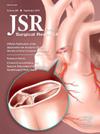Treatment of Noncompressible Torso Hemorrhage With Thermoreversible Intra-abdominal Foam: A Dose-response Study in a Porcine Model
IF 1.8
3区 医学
Q2 SURGERY
引用次数: 0
Abstract
Introduction
Noncompressible torso hemorrhage (NCTH) leads to significant mortality in civilian settings where transport to a trauma center may be delayed and is also the leading cause of exsanguination on the battlefield. Fast Onset Abdominal Management (F.O.A.M.) is a medical device under development that deploys a rapidly expanding thermoreversible foaming agent from a prefilled pressurized canister via an autostopping needle inserted into the peritoneal cavity. Previous pilot and safety studies in porcine models of NCTH have shown that F.O.A.M. increased survival and reached desired intra-abdominal pressure endpoints without significant adverse effects. However, the optimal intra-abdominal deployment pressure for the foaming agent is yet to be determined.
Methods
In this prospective study, NCTH was modeled using a modified Ross–Burns swine model wherein a grade IV-V liver laceration was made in 40 animals. Each F.O.A.M. device was set to deliver agent to a preset intra-abdominal goal pressure. The pressure for the initial cohort was 60 mmHg and the experimental pressure for each subsequent cohort of animals was selected to be the pressure with the highest posterior probability of being the minimum effective pressure based on an ordinal Bayesian continual reassessment method.
Results
After the allocation of animals to various pressures delivered by the F.O.A.M. device ranging between 50 and 80 mmHg, 33/40 swine had interpretable outcomes (e.g., technically successful device deployments). Based on a priori exclusion criteria, 7 animals were excluded from the analysis, four based on prototype device failure, and three based on off-target needle administration. At the final analysis, two pressures (70 mmHg and 80 mmHg) remained in the 95% credible interval.
Conclusions
Pressure is the gold standard for effective tamponade of bleeding. In this dose-finding study of the F.O.A.M. device for intra-abdominal tamponade of NCTH in a porcine model, we found a 95% posterior probability that either 70 mmHg or 80 mmHg is the minimum effective pressure as defined in our model. Future studies will be needed to assess long-term survival and adverse events at this pressure.
求助全文
约1分钟内获得全文
求助全文
来源期刊
CiteScore
3.90
自引率
4.50%
发文量
627
审稿时长
138 days
期刊介绍:
The Journal of Surgical Research: Clinical and Laboratory Investigation publishes original articles concerned with clinical and laboratory investigations relevant to surgical practice and teaching. The journal emphasizes reports of clinical investigations or fundamental research bearing directly on surgical management that will be of general interest to a broad range of surgeons and surgical researchers. The articles presented need not have been the products of surgeons or of surgical laboratories.
The Journal of Surgical Research also features review articles and special articles relating to educational, research, or social issues of interest to the academic surgical community.

 求助内容:
求助内容: 应助结果提醒方式:
应助结果提醒方式:


